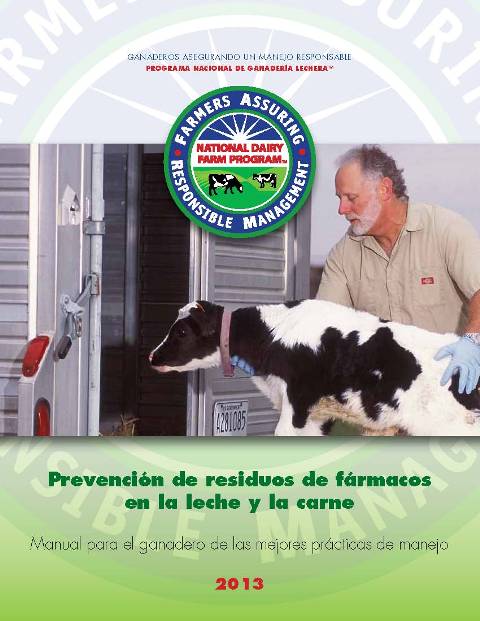Congress Extends Farms Programs into 2013 to Avert Dairy Cliff
January 08, 2013The quest to pass a new farm bill will remain NMPF’s main focus in 2013, after a last-minute fiscal cliff deal in Congress on New Year’s eve extended existing farm programs – including key dairy programs – into 2013.
“We will spend the coming months figuring out how to move farm policy forward. The status quo is not an acceptable outcome, either for farmers or taxpayers,” said Jerry Kozak, President and CEO of NMPF. The fiscal cliff package, among other things, extended the MILC program through Sept. 30th, 2013, and the price support program through Dec. 31st of this year.
Thousands of news stories in the last two weeks of December speculated that consumers would face a dairy cliff after January 1st: the return of the 1949 agriculture law that potentially could double farm-level milk prices. During a post-Christmas lame duck session, Congress considered including the Dairy Security Act – the new margin insurance-based safety net for dairy farmers – in the overall farm bill extension as a way to prevent the permanent law from returning. In the end, however, most existing programs were extended.
“As 2012 ended, we helped make visible the need to create a better dairy policy for farmers. Returning to the 1949 law is not a viable long-term solution, but neither is the system we still have, featuring price supports at ineffectively low levels, along with direct payments that don’t recognize the realities of today’s dairy sector. We need to keep that need visible in 2013 so we end up with a better system,” Kozak said.
Kozak did express satisfaction that the overall fiscal cliff deal prevented the estate tax from returning at punitively high levels in 2013. The fiscal cliff package includes a 40% rate on estates valued at more than $5 million, up from the previous 35% rate, but far less than the 55% top rate on $1 million estates that could have become permanent absent the new package.
NMPF Reorganizes to Address 2013 Industry Priorities
January 08, 2013With a new farm bill delayed at least until spring 2013 and other legislative priorities such as immigration reform coming soon to the attention of the new Congress, NMPF announced that it has reorganized its staff to better meet the challenges that are sure to come in the year ahead and promoted several staff members who will facilitate these efforts.
As first announced in December, Jim Mulhern will start next week as NMPF’s Chief Operating Officer, a new position in the organization that will bolster NMPF’s team of professionals working on issues as diverse as farm policy, labor availability, trade expansion, environmental regulation, animal care, and milk pricing. Mulhern will report to President and CEO Jerry Kozak and have direct oversight of government relations, membership, and communications activities.
In order to better coordinate the often parallel efforts of the government relations and regulatory teams, those staff members have been combined into one department that will be managed by Senior Vice President of Government Relations Dana Brooks, who will in turn report to Mulhern. Vice President of Scientific and Regulatory Affairs Jamie Jonker and regulatory staff members Beth Briczinski and Betsy Flores, who were promoted to Senior Director of Regulatory Affairs, and Senior Director of Animal Health and Welfare, respectively, will now report to Brooks.
Anuja Miner was promoted to Vice President of Membership Services and will report directly to Mulhern. Gail Mobley was made Senior Director of Finance and Administration and will continue to report to Tom Balmer, Executive Vice President.
“This reorganization will strengthen NMPF’s ability to address legislative, regulatory, and other issues that we anticipate will arise in 2013,” explained Kozak. “We want to make sure that the structure of the organization will best serve our member cooperatives and their dairy farmer owners. In addition, by recognizing the outstanding commitment to NMPF by these long-time staff members, we demonstrate their value to both NMPF and the industry at large.”
Record CWT Export Assistance Year Adds 45¢ to Farmers’ Milk Checks
January 08, 20132012 was a record year for the Cooperatives Working Together (CWT) Export Assistance program, featuring a flurry of activity to help its members. These included:
- 1,028 requests for export assist from 11 member cooperatives
- Of those, 676 requests were accepted, helping sell:
o 124.953 million pounds of Cheddar, Monterey Jack, and Gouda cheese
o 72.779 million pounds of 82% milkfat content butter
o 127,868 pounds of anhydrous milkfat
o 171,961 pounds of whole milk powder
o Shipments to 42 countries on six continents
On a milkfat basis, these sales are the equivalent of 2.743 billion pounds of milk, which is the annual milk production of 130,637 cows, and also equal to 72% the increase in 2012’s milk production.
Exports from 2011 that were shipped in 2012, along with the 2012-assisted exports shipped last year, totaled 103.6 million pounds of cheese and 58.9 million pounds of butter. CWT-assisted cheddar shipments equaled 71% of total cheddar exports, and total CWT-assisted 2012 cheese shipments equaled 18% of all 2012 cheese exports. CWT-assisted butter shipments accounted for 63% of all 2012 butter export shipments.
This quantity of additional dairy product shipments added an average of 45 cents per hundredweight to dairy farmers’ milk checks for 2012, an excellent return on an investment of just two cents per hundredweight of milk marketed.
USDA Finalizes Animal Disease Traceability Rule
January 08, 2013On December 20, 2012, the U.S. Department of Agriculture (USDA) announced a final rule establishing general regulations for improving the traceability of U.S. livestock moving interstate. Under final animal disease traceability rule, unless specifically exempted, livestock moved interstate would have to be officially identified and accompanied by an interstate certificate of veterinary inspection or other documentation, such as owner-shipper statements or brand certificates.
NMPF’s initial reaction is that the rule is a good start, but it does not meet the organization’s policy of requiring RFID tags and 48 hour traceability. The animal disease traceability final rule is expected to be published in the Federal Register on January 9, 2013.
NMPF had commented on the proposed rule, expressing support for mandatory animal identification and disease traceability to serve as a collective industry insurance policy against catastrophic animal disease outbreaks. The dairy industry has taken a strong proactive stance in advocating mandatory animal identification and disease traceability.
The rule contained the following important information for dairy producers:
- All dairy cattle females, regardless of age, and all male dairy cattle (including dairy steers) that are born after March 11, 2013, will be required to be officially identified (by a device or method approved by USDA) prior to interstate movement.
o The Final Rule defines dairy cattle as: “All cattle, regardless of age or sex or current use, that are of a breed(s) used to produce milk or other dairy products for human consumption, including, but not limited to, Ayrshire, Brown Swiss, Holstein, Jersey, Guernsey, Milking Shorthorn, and Red and Whites.” - Individual animal identification can be done by a variety of options approved by USDA, including RFID and “brite” tags.
o Beginning March 11, 2015, only identification devices beginning with 840 or other prefix representing U.S. territories will be recognized as official identification.
o NMPF policy supports the use of official 840-RFID tags for dairy cattle identification. - All dairy cattle moving interstate must be accompanied by Interstate Certificate of Veterinary Inspection or other documentation as agreed to by the receiving state.
For more information on USDA’s final animal disease traceability rule, the following documents are available online:
- The final rule to be published in the Federal Register.
- USDA’s animal disease traceability general standards.
- USDA’s traceability FAQ.
Please contact NMPF’s Jamie Jonker with any questions.
Signing of Russian Trade Legislation Sets Stage for Reopening Market to U.S. Dairy
January 08, 2013U.S. dairy suppliers have been shut out of the Russian market since September 2010. But President Obama’s Dec. 14, 2012, signing of legislation granting permanent normal trade relations (PNTR) to Russia represents a major step toward reopening business with one of the world’s largest dairy buyers.
The president’s action followed successful bipartisan votes by the House and Senate in the lame-duck session of Congress that began Nov. 13. NMPF and the U.S. Dairy Export Council (USDEC) had actively supported PNTR for Russia and applauded the government’s actions to put the bill into law.
“Without PNTR, Russia couldn’t be compelled to apply its World Trade Organization (WTO) commitments to the United States,” said USDEC President Tom Suber. “PNTR means the United States can now utilize the full WTO toolbox to help resolve issues blocking U.S. dairy trade. It also means Russia has a reason to return to the bargaining table to find a compromise to their export certification and plant inspection demands that triggered the ban in the first place.”
“We are consistently shipping more than 13 percent of the milk solids produced annually in the United States to buyers beyond our borders,” said Jerry Kozak, President and CEO of NMPF. “Given the strides made by the U.S. dairy sector in meeting the world’s dairy needs, there is no reason—outside of nontariff barriers to trade—why we should not be a player in the Russian market.”
USDEC and NMPF have worked extensively with the U.S. government for years to resolve certification issues with Russian authorities and to help provide a firm basis for restoring access for U.S. dairy exporters, but talks broke down in the shadow of the PNTR issue.
Annual Russian imports of milk powder, cheese, butterfat, whey protein and lactose averaged 434,000 tons, valued at $1.6 billion, from 2009-2011. Through three quarters of 2012, the nation was on track to hit similar numbers by year-end.
FARM Program’s 2013 Antibiotic Residue Prevention Manual Available in Spanish
January 08, 2013 Last month, NMPF released a revised version of its Spanish residue prevention manual Prevención de residuos de fármacos en la leche y la carne for 2013. As an area of focus for the National Dairy FARM ProgramTM, the manual can be found on the FARM Program’s website. This version was translated to Spanish from the revised 2013 Milk and Dairy Beef Drug Residue Prevention Manual, which was released in the fall.
Last month, NMPF released a revised version of its Spanish residue prevention manual Prevención de residuos de fármacos en la leche y la carne for 2013. As an area of focus for the National Dairy FARM ProgramTM, the manual can be found on the FARM Program’s website. This version was translated to Spanish from the revised 2013 Milk and Dairy Beef Drug Residue Prevention Manual, which was released in the fall.
The Prevención de residuos de fármacos en la leche y la carne is the Spanish version of the FARM Program’s concise review of appropriate antibiotic use in dairy animals. It’s a quick resource to review those antibiotics approved for dairy animals and can also be used as an educational tool for farm managers as they develop their on-farm best management practices necessary to avoid milk and meat residues.
Additions to the 2013 version include a section on avoiding potential residue violations from extra-label drug use in an unapproved class of cattle, cephalosporin extra-label use prohibitions, as well as an updated drug and test kit list. The 2013 manual includes a certificate of participation that can be signed by a producer and his/her veterinarian to demonstrate their commitment to the proper use of antibiotics.
“We know that there is increased attention to the use of medicines in livestock, and in order to maintain the ability to use those products, we have to demonstrate that we are using them properly,” said Jerry Kozak, President and CEO of NMPF. “We also know that a significant portion of the people who care for dairy cows speak Spanish, and we need to make this information available in Spanish as well as English.”
The Spanish manual was sponsored by Charm Sciences, IDEXX, and Pfizer Animal Health.
NMPF Accepting Applications for 2013 Scholarship Program
January 08, 2013 NMPF is now accepting applications for its National Dairy Leadership Scholarship Program for academic year 2013-2014.
NMPF is now accepting applications for its National Dairy Leadership Scholarship Program for academic year 2013-2014.
Each year, NMPF awards scholarships to outstanding graduate students (enrolled in Master’s or Ph.D. programs) who are actively pursuing dairy-related fields of research that are of immediate interest to NMPF member cooperatives and the U.S. dairy industry at large.
Graduate students pursuing research of direct benefit to milk marketing cooperatives and dairy producers are encouraged to submit an application (applicants do not need to be members of NMPF to qualify). The top scholarship applicant will be awarded the Hintz Memorial Scholarship, which was created in 2005 in honor of the late Cass-Clay Creamery Board Chairman Murray Hintz who was instrumental in establishing NMPF’s scholarship program.
Recommended fields of study include but are not limited to Agriculture Communications and Journalism, Animal Health, Animal and/or Human Nutrition, Bovine Genetics, Dairy Products Processing, Dairy Science, Economics, Environmental Science, Food Science, Food Safety, Herd Management, and Marketing and Price Analysis.
Applications must be received no later than Friday, May 3, 2013. For an application or more information, please visit the NMPF website or call the NMPF office at 703-243-6111.
Minnesota YCs Honored with Achievement Award
January 08, 2013 In recognition of their commitment to the dairy industry, managing their farm for future generations, and being active in their local community, Blue Diamond Dairy was named Minnesota’s 2012 Producer of the Year by the Minnesota Milk Producers Association.
In recognition of their commitment to the dairy industry, managing their farm for future generations, and being active in their local community, Blue Diamond Dairy was named Minnesota’s 2012 Producer of the Year by the Minnesota Milk Producers Association.
Located in Melrose, MN, Blue Diamond Dairy is operated by Glen and Sadie Frericks, who served as officers on NMPF’s 2012 Young Cooperator (YC) Advisory Council, where they represented NMPF member cooperative Land O’Lakes. The Frericks milk 75 cows and own a small flock of laying hens, as well as an assortment of other farms animals. The operation is called a “hybrid dairy” because the herd lives and grazes outside in the warm months and moves inside during the freezing months, eating mixed ration.
“We are proud of the initiative and leadership that Glen and Sadie have shown in all aspects of their life,” commented NMPF President & CEO Jerry Kozak. “They are an excellent example of the difference young producers can make in the industry, and we hope that they will continue to lead into the future.”
To learn more about life on Blue Diamond Dairy, visit their blog. A video of their farm also helps tell the story of the family for whom dairying has become a passion and lifestyle.





